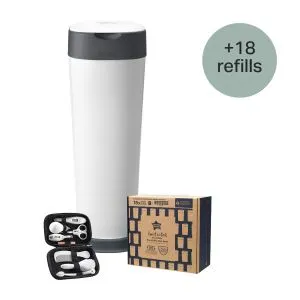
Ultimate XL Nappy Disposal Bundle with 18 Refills
Bundle & Save 40%
Subscription orders can be cancelled at anytime. Free delivery on all subsequent subscription orders. Find out more about subscriptions.
They’re easy and fuss free
Your products are automatically sent to you
You save up to 10% when you sign up for a subscription
You can cancel at any time

Weaning is an important step in a baby's development - but each little one's weaning journey is different, and there are a few different weaning styles that parents can choose from.
Let's run through how and when mums, dads and caregivers can start weaning their baby, what they can feed them, and cover a few of our top tips to help things go smoothly.
Most little ones are ready to start weaning when they're around six months old. It's best to wait until this age as before the six-month mark, they'll be getting all the nutrients they need from breast milk or formula.
By six months of age, most babies are developed enough to be able to cope with solid foods and learn how to feed themselves. They'll also be starting to become better at moving food around their mouths using their tiny tongues and developing teeth.
Some little ones may be ready for weaning sooner or later than others, but you can look out for these tell-tale signs to know when your little one is ready to start weaning:
It's good to be aware that some normal baby behaviours, such as wanting extra feeds or chewing their fists, aren't usually indicators that a baby is ready to start weaning.
Explore the Range
There are several steps within the weaning journey. Let's run through what each stage entails.
Caregivers and parents should stock up on the following bits and bobs to ensure that their weaning journey goes as smoothly as possible:
There are a couple of different approaches to weaning a baby. Some parents:
There's no right or wrong way to wean! The most important thing is that you choose a method that's right for you and your baby.
When you first start weaning, it's good to begin by offering your baby soft or pureed fruit and veg. You can then move onto chopped soft batons of food, which can be easily squashed but are sturdy enough for your little one to hold. These should be roughly the shape and size of an adult finger to help them easily be gripped.
It's important to always consider your little one's safety when choosing weaning foods to lower the risk of choking, so remember to:
Let's break down the stages of weaning and what's involved at each step.
From six months, your baby will begin to show signs that they're ready to wean. At this stage, they should be given a small amount of food before or after a milk feed and at a time when they're likely to not be too hungry or tired. Types of food given to them at this stage can include soft sticks or florets of vegetables, soft fruits, and natural yoghurt. Start with just one feed of solid foods a day, which can include purees or soft finger foods.
You can also begin to give them food items which could potentially trigger allergic reactions. It's important that these are introduced in very small quantities and just one at a time, so you're able to monitor any reactions.
As you reach the second stage of your weaning journey, you can start to offer three meals a day. These meals should be varied, as well as including iron rich-foods like legumes, dark leafy green, and whole grains.
During these months, you can introduce a wider range of tastes and textures by offering lumpier foods and herbs and spices. You should give your little one milk feeds responsively.
Between 10 and 12 months, you can continue to offer milk feeds responsively alongside giving your baby three meals a day. These can be a smaller, simpler version of family meals (with no added salt or sugar).
Your little one will now be able to chew food properly. You'll also notice that their pincer grip starts to develop, meaning they'll be able to pick up smaller pieces of food.